Canada’s progress towards global HIV targets (90-90-90), 2020
Download in PDF format
(410 KB, 1 page)
Organization: Public Health Agency of Canada
Published: 2022-07-11
There were an estimated 62,790 people were living with HIV (PLHIV) in Canada at the end of 2020
Targets for the HIV care continuum
- 90% of PLHIV were diagnosed
- 87% of people diagnosed with HIV were on treatment
- 95% of people on HIV treatment had a suppressed viral load
1 in 10 PLHIV in Canada did not know their status
An estimated 16,690 people were not engaged or represented in the HIV care continuum

Figure 1 - Text description
This pie chart shows the gaps (number and proportion) in the HIV care continuum steps.
| Gaps in Care Continuum | 2020 Estimate |
|---|---|
| Undiagnosed | 6,590; 40% |
| Diagnosed but not on treatment | 7,540; 45% |
| On treatment but not supressed | 2,560; 15% |

Figure 2 - Text description
This vertical bar graph shows the estimated number of persons in Canada at the end of 2020 who were living with HIV, and the point estimate associated with each of the three 90-90-90 targets by sex. The first bar is the number of people living with HIV. The second bar is the percentage of persons living with HIV who are diagnosed, the third bar is the percentage of persons diagnosed who are on treatment, and the fourth bar is the percentage of persons on treatment who are virally suppressed.
| 90-90-90 estimates | Males | Females |
|---|---|---|
| Number of persons living with HIV | 47,320 | 15,470 |
| Percentage of persons living with HIV who were diagnosed | 90% | 88% |
| Percentage of persons diagnosed who were on treatment | 87% | 85% |
| Percentage of persons on treatment who were virally suppressed | 96% | 90% |
Provinces/regionsFootnote 1vary on meeting HIV targets
Six of 10 jurisdictions met the first 90 target
Six of 10 jurisdictions met the second 90 target
Eight of 10 jurisdictions met the third 90 target
Key populations vary on the HIV care continuum targetsFootnote 2
- People who inject drugs (2017-2019)Footnote 3: 83%-88%-63%
- African, Caribbean and Black Community in Ontario (2018)Footnote 4 :Not available - 83-85% - 96-97%
- Gay, bisexual and other men who have sex with men (GBMSM) in three urban centres (2017-2019)Footnote 5 : 98%-96%-94%
- People incarcerated in federal correctional facilities (2020): 88%Footnote 6-98%-97%
- First Nations communities in Saskatchewan (2020): Not Available – 88%-78%
Footnotes
- Footnote 1
-
Some provinces and territories have been grouped into regions to align with how HIV care is delivered and due to small cell counts
- Footnote 2
-
Data on key populations do not always represent national-level data, and a full set of measures is not available for all communities
- Footnote 3
-
Tarasuk J, Zhang J, Lemyre A, Cholette F, Bryson M, Paquette D. National findings from the Tracks survey of people who inject drugs in Canada, Phase 4, 2017–2019. Can Commun Dis Rep 2020;46(5):138–48.
- Footnote 4
-
Ontario HIV Epidemiology and Surveillance Initiative. A Snapshot of HIV Diagnoses and the HIV Care Cascade among African, Caribbean and Black People in Ontario. Feb 7th, 2022. https://www.ohesi.ca/a-snapshot-of-hiv-diagnoses-and-the-hiv-care-cascade-among-african-caribbean-and-black-people-in-ontario/
- Footnote 5
-
Engage Cohort Site Reports. https://www.engage-men.ca/
- Footnote 6
-
A person is considered to be aware of their status if they were tested for HIV prior to incarceration, accepted voluntary testing on admission, or were referred for, or requested HIV testing during incarceration. This is a proxy the first 90 indicator for federal correctional facilities, based on currently available data.
